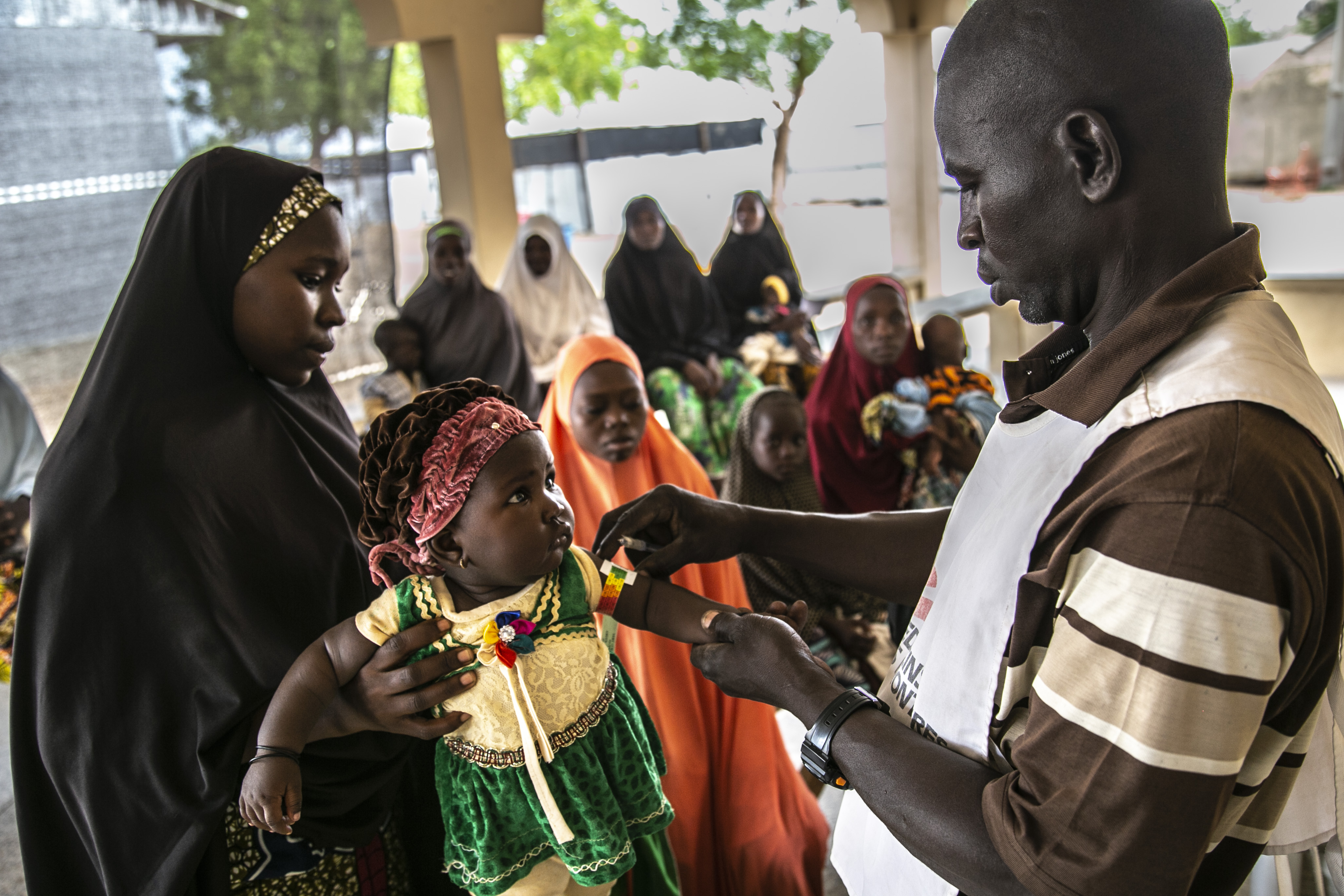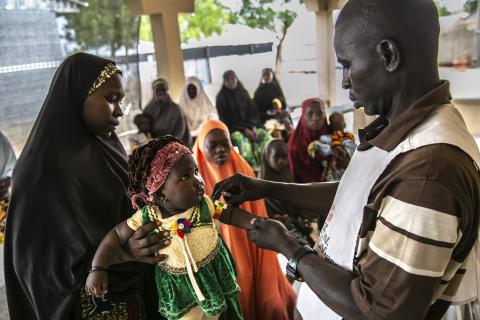“There are MAMs, then there are MAMs”
By Kirrily de Polnay
Kirrily de Polnay is a Nutrition Adviser for MSF based in Brussels and is leader of the MSF Nutrtion Working Group. She is a medical doctor by training, with a background in paediatrics. She previously worked in the field with MSF and at the Institute of Tropical Medicine in Antwerp before returning to MSF in a headquarters role in 2016.
Five expectant faces are staring at me, waiting for me to answer the question. “Well,” I start, “There are MAMs, and then there are MAMs”. Five expectant faces show a variety of frowning, nervous smiles and confused expressions.
I am standing in our inpatient nutrition ward in a hospital in Masisi, Democratic Republic of Congo. The five expectant faces are two doctors, two nurses and a nutrition assistant – we are doing the morning ward round together. Once we have all established, yes, I meant to say that, it wasn’t my bad French, I try my best to explain.
The question they asked me is one of a suite of questions I get asked by many of our projects in many different countries and continents: ‘How should we treat the children with moderate acute malnutrition (MAM) with medical complications who need hospitalisation – do we treat them as if they were suffering from severe acute malnutrition (SAM)? Do we put them through the whole nutritional treatment protocol, starting with F-75 onwards? Do we refer them to outpatient therapeutic feeding programme (OTP) nutritional care when they exit the hospital?’
At Médecins Sans Frontières (MSF), pratically all of our projects are implemented directly by MSF doctors, nurses, midwives, pharmacists, psychologists, etc., working on the ground, whether with ministry of health staff or in our own projects. We try to equip our staff to deal with the many different contexts and medical conditions with which they will be confronted through medical protocols and guidelines that take into account the latest evidence, combined with our communal clinical experience. We then try to support them through field visits, calls, skypes and emails to make sure that these protocols are achieving the quality of patient care that we all aspire to.

One of the biggest goals of this approach is to provide guidance for clinicians with differing levels of clinical experience and expertise, from the community health officer in Sierra Leone who is now working in our paediatric intensive care unit with only three years of medical education, to the first mission doctor who has ten years of experience in Europe, but has never seen a malnourished child.
We don’t always have the luxury of experienced clinicians who can take our protocols, but then use their own knowledge and experience to adapt treatment to each specific patient. This is especially the case for children with MAM with medical complications who need inpatient treatment. Complications may include shock, altered state of consciousness (coma, lethargy, drowsiness), seizures, pneumonia, diarrhoea with severe dehydration or bloody diarrhoea, severe anaemia, severe malaria, other severe infections (e.g., meningitis), severe skin condititions and congenital malformations leading to feeding difficulties, among others.
The most common approach in MSF has been to treat these children the same as those suffering from SAM, providing the same medical and nutritional treatment.
Indeed, this was the approach that I followed as a field doctor when I started with MSF in 2011. I was very new to seeing malnutrition; my training in south London had actually exposed me to advanced tuberculosis, HIV and even rickets in children, but treating kwashiorkor and other aspects of malnutrition was a huge learning curve. Even then, I had concerns as to whether this was the right thing to do for all of these children, but there were no strong international recommendations that were different to MSF’s.
The more time that I have spent caring for malnourished children, both in the field and now from headquarters, still giving clinical input into individual cases as well as working on the aforementioned protocols and guidelines, the more complicated I see the ‘MAMs with medical complications’.
One of the main issues here is a chicken-and-egg conundrum. MSF is likely to see two main profiles of MAM with medical complications – and probably everything in between. There are children who come into our health facilities who are very sick, perhaps even in a coma, who may be having a seizure, who are found to be MAM in triage. After 24 to 48 hours of appropriate treatment and close monitoring, these children are bright as buttons. This Lazarus-like ability of children to recover from illness quickly is why we love paediatrics so much.
Then there is the other profile. These children have the same presenting condition and after the initial 24 to 48 hours of treatment and monitoring are usually slightly better, but are most definitely not bouncing around the ward. These children are slower to repond and may experience some ups and downs in their condition. The general feeling is that this is a vulnerable child – one we need to watch.
We have come to think that the first profile is likely to be a child who has become severely unwell (over a period of time that it is often hard to determine) and then slipped into MAM. This child likely still has the physical resources and homeostatic buffers to br able to bounce back with appropriate treatment. The second profile is likely to be a child who has been MAM for a longer period of time, whose physiology has had to adapt and adapt again to decreasing resources, perhaps also suffering from a number of episodes of illness. There is then one severe episode that pushes them over the edge; homeostasis breaks down and their bodies can no longer cope. Their slower response to treatment, with a bumpier course, is most likely related to their exisiting MAM.
Following this train of thinking, it would seem logical that the first profile of children could be treated as MAM rather than SAM; i.e.; start them on normal food as soon as their condition is stable enough for enteral feeds (whether initially through a naso-gastric tube or straight to oral), with supplementation such as a ready-to-use-supplementary food. Indeed, as I started children with this profile on the full nutritional protocol with F-75 in my early experiences in the field, I worried they were not getting enough calories or protein to help fight their infection. Furthermore, these children were hungry! It is hard enough when you see a SAM child cry for normal food rather than F-75, but at least you know that this is the best treatment we currently have available for their condition, and that giving them normal home food could make them worse through refeeding syndrome.
For the second profile of child, the one who has likely had MAM for a long time, one can feel more confident starting them on the full nutritional protocol as it seems logical that they need a slower approach, with more attention to their metabolic stabilisation.
More often than not, it is extremely difficult to be able to tell if the sickness or the MAM came first when a child first presents. Why? There are many reasons. For example, the history given by the child’s caregiver may not be precise enough to help you to work out which profile the child fits. We often see that caretakers may not feel confident talking about a lack of food at home or a difficult situation that has led to the child having less food. We also frequently see these children brought in by their mothers, but with a history of staying with other family members while the mother works or studies elsewhere. This is a stressful time for this mother. She is unlikely to have wanted to leave her child in the first place, but it was the only way to keep her family afloat. She may feel guilty because the child became unwell or did not have access to enough food, or the right kind of food, while she was away. She is unlikely to be able to give a clear account of her child’s health during the time she was not with the child.
As mentioned previously, these two profiles are perhaps the extremes of the spectrum. The added complication to this already-complicated issue occurs when a child presents in between these two extremes: it can be even more difficult to work out the best course of action. So, how can we write a clear protocol that accounts for this complexity and caters to clinicians with differing levels of experience and capacity? Well, we probably haven’t come up with the right answer yet. What we have tried to do is to put huge emphasis on assessing next steps of care by the clinical response that we see when we start treatment, close monitoring to pick up on subtle changes in clinical condition, and discussing these cases with our medical team. That team starts with the medics in the field, but extends all the way to me in Brussels through direct emails and calls or via our telemedicine platform.
And what about follow-up? Again, we advise case-by-case and give our teams the autonomy to adapt to their context, but we all know paediatricians are control freaks, so we usually advise them to come back to our outpatient clinic for follow-up, even if our outpatient programmes don’t normally admit MAMs (something else we are trying to change at MSF…)
We all grew up in medicine working in teams; they are our support network and often our lifeline. With some of these difficult and complex questions regarding malnourished children, my medical team extends beyond MSF and into the nutrition community. I often send out my distress calls to clinicians I trust and respect, such as Jay Berkley and Indi Trehan. It brings me comfort when I find them thinking along the same lines (although they usually express it more eloquently and with a whole bunch of papers for me to read to back it up!). It is also a comfort to know that there is great research in progress, such as Mark Manary’s high-MAM tudy in Sierra Leone. Hopefully, we will soon be able to provide better guidance to our clinicians in the field and deliver the best possible care to these little ones with MAM.
For more information please contact Kirrily de Polnay.


